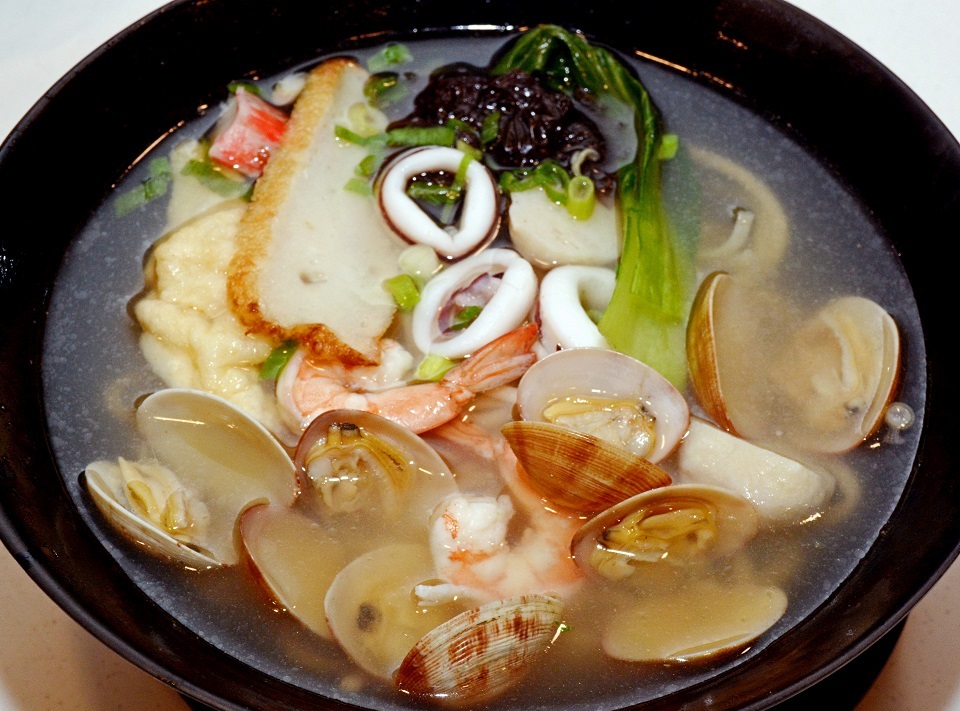Filtered By: Lifestyle
Lifestyle
Bite-Size
A soup crawl at SM MOA
By VERONICA PULUMBARIT

A chef makes noodles using a Chinese technique known as La Mian, in which the dough is pulled and twisted into noodles, at Mey Lin Pot and Noodle House. Photos: Riz Pulumbarit
It has been nearly a decade since the 42-hectare mall opened its doors, and over the years it has become a veritable destination for diners with its more than 360 restaurants, buffets, bars and grills, pastry shops, coffee shops and, of course, noodle and tea houses.
This rainy season, everybody craves for a bit of hot, soothing soup. Soups are the ultimate comfort food; a warm bowl of savory broth can nourish the body and lift the spirit. It is almost impossible to try all the soup choices at the Mall of Asia, but here are some that caught our attention during a recent food crawl at the mall.
Mey Lin Pot and Noodle House
Ground Level, North Building
“La Mian,” or the Chinese art of hand-pulled noodles, is what attracted us to Mey Lin Pot and Noodle House. Its two chefs have been trained in this method of transforming wheat dough into delectable noodles through a special pulling technique.

Mey Lin's Seafood Soup
No kitchen instruments are used in the making of Mey Lin's noodles. Every strand of noodle is carefully and painstakingly made by the chefs who repeatedly fold and pull the dough until thin noodles are formed.
Historical evidence points to noodle-making in China as early as the Eastern Han Dynasty 1,900 years ago. However, it was only during the Sung Dynasty (around the year 960 to the 1200s) that noodles were formally named “mian.” Mian means noodles made from wheat.
Four Seasons Hotpot City
Bldg. E, By the Bay, MOA Complex, Pasay City
The name "Four Seasons" fits this restaurant. You can have a dish from any “season” by creating one. That’s the beauty of dining at this restaurant. You have the freedom to create your own hot dishes.
The restaurant has an elaborate choice of soup bases, seasonings, fresh vegetables, meats, dimsum, and more. It is easy to lose one’s way around this massive restaurant and it would be best to ask the servers for guidance and advice.
For those who are not interested in creating their own dishes, they can go to the far end of the restaurant where there is a wide selection of viands. To end the meal on a sweet note, head to the dessert section where there is an assortment of fruits, cakes, pastries and ice cream.
Ya Kun Kaya
Ground Level, North Building

Ya Kun Kaya's Bak Kut Teh soup has no noodles, just meat and tea-based broth.
We are more familiar with soups that have noodles, meat, and vegetables, so it was odd to be served with soup that had nothing but broth and pork ribs.
But the taste was amazing, and it’s no wonder that Bak Kut Teh is one of the most popular dishes in Singapore.
The broth is made from tea with 15 spices. It is rich and flavorful even though it looked almost clear. The pork rib was tender and very tasty and filling.
It was definitely a pleasant surprise to discover this soup.
Kimono Ken
Ground Level, North Building
It must be the soy-based broth, but Kimono Ken’s Shoyu Ramen with chasu slices and vegetables was one of the best soups we have ever tasted.
“Hours.” We were told that is how long it takes to prepare this magical broth. What could they have put in it that made it so tasty?
The noodles themselves were not particularly special, but the thin slices of pork in the soup were delightful. They were tenderly seasoned and did not overpower the dish. They certainly gave the soup a pleasant texture.
Lugang Cafe
Ground Floor, South Wing

Lugang Cafe's Szechuan Dan-Dan Noodles with Peanut Sauce
The noodles were cooked perfectly and served at the right temperature. Many may overlook these details, but these basics are difficult to master.
The Szechuan Dan-Dan Noodles with Peanut Sauce was artistically presented, with the noodles and spices all bundled up in the middle of the bowl. Admittedly, the peanut sauce with hints of different spices, will probably not be to the liking of Filipinos who are more familiar with meat-based broths. However, it’s something that adventurous palates would be interested to try. — BM, GMA News
Tags: restaurantreviews, soup
More Videos
Most Popular




